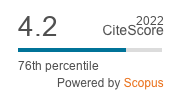Characteristics of fluvial islands along three gravel bed-rivers of North-Eastern Italy
DOI:
https://doi.org/10.18172/cig.2505Keywords:
fluvial island, gravel bed river, Piave River, Tagliamento River, Brenta RiverAbstract
River islands are defined as discrete areas of woodland vegetation located in the riverbed and surrounded by either water-filled channels or exposed gravels, exhibiting some stability and remaining exposed during bank-full flows. Islands are very important from both morphological and ecological points of view, representing the most natural condition of a fluvial system and are strongly influenced by human impacts. This study aims at analyzing the morphological and vegetation characteristics of three different types of islands (pioneer, building and established) in three distinct rivers in the NE of Italy, affected by different intensities of human pressure. The study was conducted on several sub-reaches of the Piave, Brenta and Tagliamento rivers. The first is a gravel-bed river, which suffered intense and multiple human impacts, especially due to dam building and in-channel gravel mining. The same alterations can also be observed in the Brenta River, which also presents bank protections, hydropower schemes and water diversions. On the other hand, the Tagliamento River is a gravel-bed river characterized by a high level of naturality and very low human pressures. The analyses were conducted using aerial photographs and LiDAR data acquired in 2010 in order to define and distinguish the three different island types and to obtain a characterization of ground and vegetation features. The results suggest that the fluvial islands lie at different elevations and this fact implies a different resistance capacity during flood events. Pioneer islands and building islands lie at lower elevations than established islands causing a lower capacity to survive during considerable flood events, in fact in most cases those islands types were removed by ordinary floods. Established islands lie at higher elevations and only intense and infrequent flood events (Reccurence Interval> 10-15 years) are able to determine considerable erosions. Regarding the characteristics of vegetation, we can observe a strong distinction between the three types. Established islands always exhibit the greatest vegetation height and the presence of these plants, sometimes higher than 30 m, contributes to increase the resistance and the stability of these components of fluvial systems.
Downloads
References
Arscott, D.B., Tockner, K., Ward, J.V. 2000. Aquatic habitat diversity along the corridor of an Alpine floodplain river (Fiume Tagliamento, Italy). Archiv für Hydrobiologie 149, 679-704.
Bendix, J., Hupp, C.R. 2000. Hydrological and geomorphological impacts on riparian plant communities. Hydrological Processes 14, 2977-2990.
Bertoldi W., Zanoni, L., Tubino, M. 2009. Planform dynamics of braided streams. Earth Surface Processes and Landforms 34, 547-557.
Braatne, J.H., Rood, S.B., Simons, R.K., Gom, L.A., Canali, G.E. 2003. Ecology of riparian vegetation of the Hells Canyon corridor of the Snake River: field data, analysis and modeling of plantresponses to inundation and regulated flows. Technical Report Appendix E. 3. 3-3. Idaho Power Company. Boise, Idaho, USA.
Church, M., Rice, S.P. 2009. Form and growth of bars in a wandering gravel-bed river. Earth Surface Processes and Landforms 34 (10), 1422-1432.
Comiti, F., Da Canal, M., Surian, N., Mao, L., Picco, L., Lenzi, M. A. 2011. Channel adjustments and vegetation cover dynamics in a large gravel bed river over the last 200 years. Geomorphology 125, 147-159.
Edwards, P.J., Kollman, J., Gurnell, A.M., Petts, G.E., Tockner, K., Ward, J.V. 1999. A conceptual model of vegetation dynamics on gravel bars of a large alpine river. Wetlands Ecology and Management 7, 141-153.
Gray, D., Harding, J.S. 2007. Braided river ecology, a literature review of physical habitats and aquatic invertebrate communities. Science for conservation 279, Science & Technical Publishing, Department of Conservation,Wellington, New Zealand.
Gurnell, A.M., Petts, G.E., Hannah, D.M., Smith, B.P.G., Edwards, P.J., Kollmann J., Ward J.V., Tockner, K. 2001. Riparian vegetation and island formation along the gravel-bed Fiume Tagliamento, Italy. Earth Surface Processes and Landforms 26, 31-62.
Gurnell, A.M., Petts, G.E. 2002. Island-dominated landscapes of large floodplain rivers, a European perspective. Freshwater Biology 47, 581-600.
Hooke, J.M. 1986. The significance of mid-channel bars in an active meandering river. Sedimentology 33 (6), 839-850.
Hooke, J.M., York, L. 2011. Channel bar dynamics on multi-decadal timescales in an active meandering river. Earth Surface Processes and Landforms 36, 1910-1928.
Hupp, C.R., Osterkamp, W.R. 1996. Riparian vegetation and fluvial geomorphic processes. Geomorphology 14, 277-295.
Kellershals, R., Asce, M., Church, M., Bray, D.I. 1976. Classification and Analysis of River Processes. ASCE Journal of the Hydraulics Division, July, 1976.
Kiss, T., Andrasi, G., Hernesz, P. 2011. Morphological alteration of the Dráva as the result of human impact. Acta Geographica Debrecina. Landscape and Environment Series 5 (2), 58-75.
Kollmann, J., Vieli, M., Edwards, P.J., Tockner, K., Ward, J.V. 1999. Interactions between vegetation development and island formation in the Alpine river Tagliamento. Applied Vegetation Science 2, 25-36.
Kondolf, G.M. 1997. Hungry water: effects of dams and gravel mining on river channels. Environmental Management 21 (4), 533-551.
Leopold, L.B., Wolman, M.G., Miller, J.P. 1964. Fluvial processes in geomorphology. Freeman, San Francisco, USA.
Mikus, P., Wyzga, B., Kaczka, R.J., Walusiak, E., Zawiejska, J. 2013. Islands in a European mountain river: Linkages with large wood deposition, flood flows and plant diversity. Geomorphology 202, 115-127.
Moretto, J., Rigon, E., Mao, L., Picco, L., Delai, F. Lenzi, M.A. 2013. Channel adjustments and Island dynamics in the Brenta River (Italy) over the last 30 years. River Research and Appliccations. doi: 10.1002/rra.2676.
Osterkamp, W.R. 1998. Processes of fluvial island formation, with examples from Plum Creek, Colorado and Snake River, Idaho. Wetlands 18, 530-545.
Picco, L. 2010. Long period morphological dynamics in regulated braided gravel-bed rivers: comparision between Piave River (Italy) and Waitaki River (New Zealand). PhD thesis, University of Padova, 190 pp.
Picco, L., Mao, L., Rigon, E., Moretto, J., Ravazzolo, D., Delai, F., Lenzi, M.A. 2012a. Medium term fluvial island evolution in relation with flood events in the Piave River. WIT Transactions on Engineering Sciences 73, 161-172.
Picco, L., Mao, L., Rigon, E., Moretto, J., Ravazzolo, D., Delai, F., Lenzi, M.A. 2012b. Riparian forest structure, vegetation cover and floods events in the Piave River (Northeast of Italy). WIT Transactions on Engineering Sciences 73, 161-172.
Picco, L., Mao, L., Cavalli, M., Buzzi, E., Rainato, R., Lenzi, M.A. 2013. Evaluating short-term morphological changes in a gravel-bed braided river using terrestrial laser scanner. Geomorphology 201, 323-334.
Picco, L., Mao, L., Rainato, R., Lenzi, M.A. 2014. Medium-term fluvial island evolution in a disturbed gravel-bed river (Piave River, Northeastern Italian Alps), Geografiska Annaler: Series A, Physical Geography, 96, 85-97. doi: 10.1111/geoa.12034.
Poff, N.L., Olden, J.D., Merritt, D.M., Pepin, D.M. 2007. Homogenization of regional river dynamics by dams and global biodiversity implications. Proceedings of the National Academy of Sciences 104, 5732-5737.
Tabacchi, E., Correll, D.L., Hauer, R., Pinay, G., Planty-Tabacchi, A.M., Wissmar, R.C. 1998. Development, maintenance and role of riparian vegetation in the river landscape. Freshwater Biology 40, 497-516.
Van der Nat, D., Tockner, K., Edwards, P.J., Ward, J.V., Gurnell, A.M. 2003. Habitat change in braided flood plains (Tagliamento, NE-Italy). Freshwater Biology 48, 1799-1812.
Ward J.V., Tockner K., Edwards P.J., Kollmann J., Bretschko G., Gurnell A.M., Petts G.E., Rossaro, B. 1999. A reference river system for the Alps: the Fiume Tagliamento. Regulated rivers: Research & Management 15, 63-75.
Wyrick, J.R. 2005. On the formation of fluvial islands. PhD Thesis, Oregon State University, USA, 302 pp.
Wyrick, J.R., Klingeman, P.C. 2011. Proposed fluvial island classification scheme and its use for river restoration. River Research and Applications 27, 814-825.
Zanoni, L., Gurnell, A., Drake, N., Surian, N. 2008. Island dynamics in a braided river from análisis of historical maps and air photographs. River Research and Applications 24, 1141-1159.
Downloads
Published
How to Cite
Issue
Section
License
The authors retain copyright of articles and authorize Cuadernos de Investigación Geográfica / Geographical Research Letters the first publication. They are free to share and redistribute the article without obtaining permission from the publisher as long as they give appropriate credit to the editor and the journal.
Self-archiving is allowed too. In fact, it is recommendable to deposit a PDF version of the paper in academic and/or institutional repositories.
It is recommended to include the DOI number.
This journal is licensed under a Creative Commons Attribution 4.0 International License











